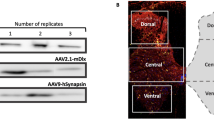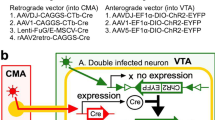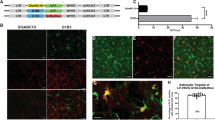Abstract
Previous methods of in vivo gene transfer to differentiated neurons of the adult mammalian brain have been inefficient and associated with technical problems. We have therefore developed a model system of direct gene transfer using a replication–defective adenoviral vector containing a β–galactosidase gene to transduce brain neurons. Following injection of purified high titre recombinant adenovirus into the caudate putamen of seven week old mice, lacZ activity was evident in neural components of the central nervous system (CNS) for at least 8 weeks post infection. The efficiency of adenoviral gene transfer was very high compared to other techniques, suggesting an attractive and efficient alternative for neuronal gene transfer in vivo.
This is a preview of subscription content, access via your institution
Access options
Subscribe to this journal
Receive 12 print issues and online access
$209.00 per year
only $17.42 per issue
Buy this article
- Purchase on Springer Link
- Instant access to full article PDF
Prices may be subject to local taxes which are calculated during checkout
Similar content being viewed by others
References
Neufeld, E.F. & Muenzer, J. in Metabolic Basis of Inherited Disease 6th edn (eds Scriver, C.R. et al.) 1565–1588 (McGraw Hill, New York, 1989).
Anderson, W.F. Prospects for human gene therapy. Science 226, 401–409 (1984).
Palella, T. et al. Expression of human HPRT mRNA in brains of mice infected with a recombinant herpes simplex virus-1 vector. Gene 80, 137–144 (1989).
Fink, D.J. et al. In vivo expression of β-galactosidase in hippocampal neurons by HSV-mediated gene transfer. Hum. Gene Ther. 3, 11–19 (1992).
Wolfe, J.H. et al. Herpes virus vector gene transfer and expression of β-glucuronidase in the central nervous system of MPS VII mice. Nature Genet. 1, 379–384 (1992).
Price, J., Turner, D. & Cepko, C. Lineage analysis in the vertebrate nervous system by retrovirus-mediated gene transfer. Proc. natn. Acad. Sci. U.S.A. 84, 156–160 (1987).
Walsh, C. & Cepko, C.L. Clonally related cortical cells show several migration patterns. Science 241, 1342–1345 (1988).
Ono, T., Fujino, Y., Tsuchiya, T. & Tsuda, M. Plasmid DNAs directly injected into mouse brain with lipofectin can be incorporated and expressed by brain cells. Neurosci. Lett. 117, 259–263 (1990).
Jiao, S., Acsadi, G., Jani, A., Felgner, P.L. & Wolff, J.A. Persistence of plasmid DNA and expression in rat brain cells in vivo. Exp. Neurol. 115, 400–413 (1992).
Rosenfeld, M.A. et al. Adenovirus-mediated transfer of a recombinant α1-antitrypsin gene to the lung epithelium in vivo. Science 252, 431–434 (1991).
Rosenfeld, M.A. et al. In vivotransfer of the human cystic fibrosis transmembrane conductance regulator gene to the airway epithelium. Cell 68, 143–155 (1992).
Jaffe, H.A. et al. Adenovirus-mediated in vivo gene transfer and expression in normal rat liver. Nature Genet. 1, 372 (1992).
Quantin, B., Perricaudet, L.D., Tajbakhsh, S. & Mandel, J.L. Adenovirus as an expression vector in muscle cells in vivo. Proc. natn. Acad. Sci. U.S.A. 89, 2581–2584 (1992).
Hurwitz, D.R. & Chinnadurai, G. Evidence that a second tumor antigen coded by adenovirus early gene region E1a is required for efficient cell transformation. Proc. natn. Acad. Sci. U.S.A. 82, 163–167 (1985).
Graham, F.L. & van der Eb, A.J. A new technique for the assay of infectivity of human adenovirus 5 DNA. Virology 52, 456–467 (1973).
Engelhardt, J.F., Allen, E.D. & Wilson, J.M. Reconstitution of tracheal grafts with a genetically modified epithelium, Proc. natn. Acad. Sci. U.S.A. 88, 11192–11196 (1991).
Reynolds, B.A. & Weiss, S. Generation of neurons and astrocytes from isolated cells of the adult mammalian central nervous system. Science 255, 1707–1710 (1992).
Ishibashi, M. & Yasue, H. in The Adenoviruses (ed. Ginsburg, H.S.) 497–562 (Plenum, New York, 1984).
Kagiyama, N., Takakura, A. & Itoh, T. A serological survey on 15 murine pathogens in mice and rats. Jikken Dobutsu 35, 531–536 (1986).
Ball, A.O., Williams, M.E. & Spindler, K.R. Identification of mouse adenovirus type 1 early region 1: DNA sequence and a conserved transactivating function. J. Virol. 62, 3947–3957 (1988).
Peters, A., Palay, S.L. & Webster, H.D. The Fine Structure of the Nervous System (Harper and Row, New York, 1970).
Windle, W. Biology of Neuroglia (Charles C.Thomas, Springfield, 1958).
Author information
Authors and Affiliations
Rights and permissions
About this article
Cite this article
Davidson, B., Allen, E., Kozarsky, K. et al. A model system for in vivo gene transfer into the central nervous system using an adenoviral vector. Nat Genet 3, 219–223 (1993). https://doi.org/10.1038/ng0393-219
Received:
Accepted:
Issue Date:
DOI: https://doi.org/10.1038/ng0393-219
This article is cited by
-
Viral tools for neuroscience
Nature Reviews Neuroscience (2020)
-
Biologically active polymer nanosystems
Russian Chemical Bulletin (2017)
-
Retargeted adenoviruses for radiation-guided gene delivery
Cancer Gene Therapy (2016)
-
Electroporation markedly improves Sleeping Beauty transposon-induced tumorigenesis in mice
Cancer Gene Therapy (2014)
-
SOD1 gene transfer into paraventricular nucleus attenuates hypertension and sympathetic activity in spontaneously hypertensive rats
Pflügers Archiv - European Journal of Physiology (2013)



